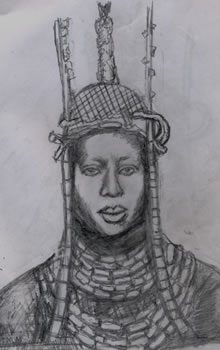|
||||||||||||||
|
||||||||||||||
palm oil, pepper, cloth, beads directly and slaves brought into her Ughoton port from surrounding territories under Edo Empire. The first guns came into Benin through this route, as did iron bars from Holland for the five blacksmith guilds, and the manila currency melted into raw materials for the exquisite Benin bronze masterpieces in all the leading museums of the world today. The cowry currency also came through the route to facilitate Edo´s economic buoyancy. The Ijebu towns all the way to Ikorodu, on the route, provided Benin with woven cloth, which became the major item of trading on the route with European traders, who re-traded the cloth at ports on the West African coast and the Congo, in exchange for slaves and gold. Of course, the Roman Catholic fathers brought the Bible with one hand and enslaved the natives with the other through the route. Oba Orhogbua enforced tribute payments from all parts of his Empire and in the 1550s conquered all the coastal lands, up to Lagos where he left a permanent garrison. The Benin maritime army was borne on river-craft flotillas. Orhogbua's conquering expedition recognized the importance of Lagos Island, both as a military defence point, and a look-out post for traffic from around the world, intending to explore the interior of Africa from the West African coastline break that allows water to flow from the Benin River into the Atlantic Ocean. Ships from the outside world could penetrate into the bowels of Africa from there so the Island entry point was considered the perfect place to monitor and control the trade. Orhogbua occupied the Island, which he called Eko (meaning camp), by setting up the first human settlement there. Oba Orhogbua's son was the first Eleko (Oba) of Lagos. From Lagos, Orhogbua explored the lagoon system to its farthest points through Dahomey, Togo, to the Volta River and Basin in today´s Ghana. Until the Biafran Civil War, it was believed even by opponents in war, that the Benin person was immune from drowning in the River Niger because of a covenant the Spirit of the river, (known by the Bini as Ohinmwin, and by the western Ibos, as Oshimili), had with Oba Ewuare. The Spirit always threw the drowning Edo person out of the water. Not servicing the covenant for hundreds of years, may have got the Spirit angry in modern times. The lagoon expedition introduced common salt (umwen) for the first time to Benin, displacing eventually, odoo, which was the Benin traditional salt. The sample salt acquired the name umwen because an Ishan servant of Chief Osague, asked to taste the salt, said in tasting it, that it was ?Obhen,? meaning, all right. Ekenika played a prominent role in Oba Orhogbua's military campaigns that brought the Lagoon lands all the way to the Atlantic Ocean where it is known as the Bight of Benin, under the control of Benin. He was a commander in Orhogbua's maritime army, and the first person to step on the uninhabited Island of Lagos. He beat back Aworis counter attacks from the mainland. The Aworis had noticed some discarded ebieba leaves, (used in wrapping food by the Benin soldiers), floating on the water. They were tropical forest leaves strange to the brackish mangrove swamplands of the lagoon so, they knew they had strangers in their midst and attacked from the direction the leaves were coming. Ekenika was rewarded with the title of Ezomo of Benin. The first person in Benin history to bear the title. Ekenika was set up at Uzebu quarters in Benin City by Oba Orhogbua, to closely monitor Benin´s most important route, territories and population, and to provide regular backing for the Lagos camp. Both Lagos and Uzebu habitations, therefore, came on stream at the same time. Uzebu was at the western outskirt of Benin, straddling the city gateway to the sea through Ughoton, the lagoon territories and people, under the control of Benin from that area, and opened Edo to Europe and the world. The Uzebu quarters served as training ground and store of weapons for the soldiers of the lagoon campaigns. The Portuguese would have lent a hand, particularly in the training and use of fire arms and cannons. Oba Orhogbua was virtually a Portuguese anyway. A very close relationship existed between Benin and Portugal at his time. Ezomo's permanent residence or palace was at the heart of Uzebu quarters, as the commander of the Uzebu military camp. Ekenika Uzebu activities and campaigns triggered and influenced the development, origin and background of the controlling elite and names, of towns and cities along the Benin riverine route: Ijebu Ode, Ijebu-Mushin, Ijebu-Ife, Ijebu-Ugbo, Ijebu-Remo, Ijebu-Oro, Ijebu-Ijesha in Ijesha land, Ijebu-Owo in Owo land. There are strong family links between Ekenika and the nobles in all the territories of the Benin riverine route. The traditional head of Owo town for instance, bears the name Ojomo, the full title being Ojomo-Olude. The Obazuaye family in Benin descends from Ekenika and the Lagos branch of the family are the Bajulaiyes. The prominent Olisa clan in Ikorodu and Ijebu Ode are related to the Oliha, the head of the Uzama group in Benin. There are many more of such links with Benin around West Africa. The Ijaw kingdom of Ogba in Bayelsa state has a concentration of the descendants of the Ekenika, particularly in the village of Akabuka.
Comment Form is loading comments...
|
||||||||||||||
|
| ||||||||||||||






